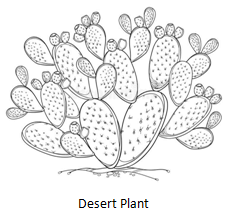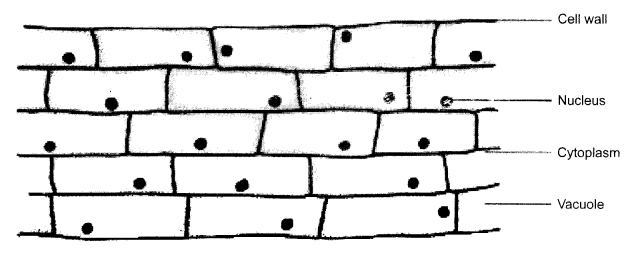Notes: living Organisms & Surroundings | Science & Pedagogy Paper 2 for CTET & TET Exams - CTET & State TET PDF Download
Aquatic habitat
- When organisms live in water, this place of living is known as aquatic habitat.
- Ponds, lakes, rivers, oceans, etc., are examples of aquatic habitat.
- Water is a medium in aquatic habitat.
Terrestrial habitat
- When organisms live on land, this place of living is known as terrestrial habitat.
- Forests, deserts, orchards, tea gardens and mountains are the examples of terrestrial habitat.
- Air is the medium in terrestrial habitat.
Mountain
- The mountain is a special terrestrial habitat where temperature is very low and most of the areas are covered with snow.
- The plants like grasses, mosses and lichens and animals like snow bear, fox, water fowl, musk deer and wolf are found commonly in this habitat.
Several kinds of plants and animals may share the same habitat.
Adaptation: The change of specific features and habits, which enables a plant or an animal to live in a particular habitat is called adaptation.
Components of a habitat

Light
- The sunlight is essential for the survival of the biotic components as the sun is the ultimate source of energy for all living things.
- The sunlight affects growth, flowering, seed germination and in many other ways in plants. Indoor plants put in the shade for a long time grow faster but become delicate and weak.
- Light also affects animals. Animals living in caves and burrows where sunlight cannot reach have very much reduced eyes e.g., Proteus. Amblyopsis do not have eyes.
- Nocturnal animals: Some animals like bats, cockroaches and owls are called nocturnal as they are active during night.
Temperature
- Temperature regulates growth, movement, reproduction, morphology and other aspects of life.
- Animals living in hot areas e.g., snakes, desert rats and lizards are not able to get sufficient water. They have thick skin and do not sweat.
- Desert animals e.g., camel have long legs. Long legs help them to lift their body above the ground. Thus, they are able to avoid direct contact with the hot ground.
Water
- All living organisms need water for their survival.
- Aquatic plants: These have the following adaptations:
- Root system is poorly developed.
- Air filled cavities found inside the body make them spongy and buoyant.
- Leaves in submerged plants are thin and narrow; while in floating plants, they are big and flat with waxy coating.
- Desert plants: These have the following adaptations:
- Well-developed root systems.
- Stem is succulent and spongy which help in storage of water. It is also green and performs photosynthesis.
- Stomata (sunken) are less in number.
- Leaves are either very small or converted into spines.
- Fish: It has the following adaptation:
- Tapering ends.
- Slippery scales which help in swimming.
- Gills for respiration.
- Phytoplanktons: These are floating plants, in aquatic habitat.
- Zooplankton: These are small animals floating on the surface of aquatic habitat.

Interaction of biotic and abiotic components: Organisms do not live in isolation but are interdependent.
Living things: These are the objects which need water, air and nutrients for their survival
Non-living things: These are the objects which do not need water, air and nutrients for their survival.
Cell: It is the basic structural and functional unit of the living things. The structure of a cell can be seen in the peel of an onion bulb or from the lower surface of a leaf under a magnifying glass or a microscope.

Life: It is a process seen only in living objects in the form of growth, movement, feeding or eating, sensitivity, respiration, excretion and reproduction.
Characteristics of the living things
All living things on this earth possess certain basic characteristics. These include the following:- Growth
- Movement
- Feeding
- Responsiveness
- Excretion
- Respiration
- Cellular structure
- Reproduction
- Adaptation.
Growth: It is defined as the permanent irreversible increase in the size and total weight of the living object.
- Animals grow for a certain period.
- In case of trees, growth takes place throughout the life.
- Growth in plants and animals is influenced by several factors like food, climate, life style, etc.
Life Span: Each animal lives for a certain period. This period is referred to as life span.
Movement: Change in the position from one place to other is called movement.
- Locomotion: The movement involving change of place in animals is called locomotion.
- Animals use wings (bird), fins (fish), limbs (cow, horse, buffalo, man) for locomotion.
- Plants generally show movements of various parts, e.g., flower buds open, roots grow away from light, when we touch the leaves of mimosa (touch me not), they shrivel up.
Cellular Structure
- Cells constitute plants and animal bodies.
- Cells are organised in various ways in different organisms.
- They help in carrying out various functions like nutrition, respiration, etc.
- They are called structural and functional unit of all living organisms.
Nutrition: The process of taking food by organisms is generally referred to as nutrition or nourishment.
- Food and water are essential for life.
- Food provides energy that helps in the growth of body and its repair.
- Autotrophs: They are the living forms which can synthesize their own food by photosynthesis, e.g., green plants.
- Heterotrophs: They are the living organisms which cannot manufacture their own food, e.g., all animals.
- Saprophytes: The living organisms which obtain their nutrition from the dead plants and animals are called saprophytes.
- Parasites: The plants and animals that feed on the other living bodies are called parasites.
Respiration
- Respiration is a process in which oxygen taken by an organism combines with reserved food, undergoes oxidation and releases energy.
- Breathing: Taking in air and releasing it in animals is referred to as breathing.
- We inhale oxygen (O2) and exhale carbon dioxide (CO2).
Excretion
- The removal of excretory waste from the body of a living being is called excretion.
- The process of removal of wastes in plants is referred to as secretion.
- Latex, resin and gum are wastes for the plant but useful for us.
Response to Stimuli
- Living beings respond to changes in their surroundings.
- Stimuli: The factors like food, water, light, touch, gravitational force, etc., are stimuli (stimulus) to which plants and animals respond.
Reproduction
- The process of a living being to produce of its own kind is called reproduction.
- Life produces life.
- Plants reproduce through seeds. Some plants also reproduce through vegetative parts.
Adaptation: The change in specific features and habits which enable a plant or an animal to live in a particular habitat is called adaptation.
Aquatic habitat: When organisms live in water, their place of living is known as aquatic habitat.
Biotic component: Living things of a habitat form its biotic component.
Excretion: The removal of nitrogeneous waste substances from the body of a living being is called excretion.
Growth: Increase in size and total weight of the living organism is called growth.
Habitat: The place where an organism survives, flourishes and reproduces is called its habitat.
Living things: These are the things which need water, air and nutrients for their survival.
Reproduction: The process of a living being to produce of its own kind is called reproduction.
Respiration: Respiration is a process in which air taken by an organism combines with the reserved food, undergoes oxidation and releases energy.
Stimulus: The factors like food, water, light, touch, gravitational force, etc., are stimuli to which plants and animals respond.
|
35 videos|145 docs|32 tests
|
FAQs on Notes: living Organisms & Surroundings - Science & Pedagogy Paper 2 for CTET & TET Exams - CTET & State TET
| 1. What is the importance of understanding the relationship between living organisms and their surroundings? |  |
| 2. How does the knowledge of living organisms and surroundings help in conservation efforts? |  |
| 3. What are some examples of interactions between living organisms and their surroundings? |  |
| 4. Why is it important for educators to include lessons on living organisms and surroundings in the curriculum for CTET and State TET exams? |  |
| 5. How can teachers incorporate hands-on activities related to living organisms and surroundings in their classroom teaching for CTET and State TET exams? |  |






















